Digital versus Conventional Impression Taking Focusing on Interdental Areas: A Clinical Trial
Abstract
1. Introduction
2. Materials and Methods
3. Results
4. Discussion
5. Conclusions
Author Contributions
Funding
Acknowledgments
Conflicts of Interest
References
- Jordan, R.A.; Bodechtel, C.; Hertrampf, K.; Hoffmann, T.; Kocher, T.; Nitschke, I.; Schiffner, U.; Stark, H.; Zimmer, S.; Micheelis, W. The Fifth German Oral Health Study (Fünfte Deutsche Mundgesundheitsstudie, DMS V)—Rationale, design, and methods. BMC Oral Health. 2014, 14, 161. [Google Scholar] [CrossRef] [PubMed]
- Demmer, R.T.; Papapanou, P.N. Epidemiologic patterns of chronic and aggressive periodontitis. Periodontol. 2000 2010, 53, 28–44. [Google Scholar] [CrossRef] [PubMed]
- Eke, P.I.; Wei, L.; Borgnakke, W.S.; Thornton-Evans, G.; Zhang, X.; Lu, H.; McGuire, L.C.; Genco, R.J. Periodontitis prevalence in adults >/= 65 years of age, in the USA. Periodontol. 2000 2016, 72, 76–95. [Google Scholar] [CrossRef] [PubMed]
- Martinez-Canut, P.; Carrasquer, A.; Magan, R.; Lorca, A. A study on factors associated with pathologic tooth migration. J. Clin. Periodontol. 1997, 24, 492–497. [Google Scholar] [CrossRef] [PubMed]
- Brunsvold, M.A. Pathologic tooth migration. J. Periodontol. 2005, 76, 859–866. [Google Scholar] [CrossRef]
- Melsen, B. Adult Orthodontics; Wiley-Blackwell: Chichester, UK, 2012. [Google Scholar]
- Proffit, W.; Fields, H.; Sarver, D. Contemporary Orthodontics, 5th ed.; Elsevier Mosby: Saint Louis, MO, USA, 2013. [Google Scholar]
- Elkholy, F.; Schmidt, F.; Jager, R.; Lapatki, B.G. Forces and moments delivered by novel, thinner PET-G aligners during labiopalatal bodily movement of a maxillary central incisor: An in vitro study. Angle Orthod. 2016, 86, 883–890. [Google Scholar] [CrossRef]
- Elkholy, F.; Schmidt, F.; Jager, R.; Lapatki, B.G. Forces and moments applied during derotation of a maxillary central incisor with thinner aligners: An in-vitro study. Am. J. Orthod. Dentofac. Orthop. 2017, 151, 407–415. [Google Scholar] [CrossRef]
- Rossini, G.; Parrini, S.; Castroflorio, T.; Deregibus, A.; Debernardi, C.L. Periodontal health during clear aligners treatment: A systematic review. Eur. J. Orthod. 2015, 37, 539–543. [Google Scholar] [CrossRef]
- Levrini, L.; Mangano, A.; Montanari, P.; Margherini, S.; Caprioglio, A.; Abbate, G.M. Periodontal health status in patients treated with the Invisalign® system and fixed orthodontic appliances: A 3 months clinical and microbiological evaluation. Eur. J. Dent. 2015, 9, 404–410. [Google Scholar] [CrossRef]
- Kim, T.W.; Echarri, P. Clear aligner: An efficient, esthetic, and comfortable option for an adult patient. World J. Orthod. 2007, 8, 13–18. [Google Scholar]
- Weir, T. Clear aligners in orthodontic treatment. Aust. Dent. J. 2017, 62, 58–62. [Google Scholar] [CrossRef] [PubMed]
- Boyd, R.; Miller, R.; Vlaskalic, V. The Invisalign System in Adult Orthodontics: Mild Crowding and Space Closure Cases. J. Clin. Orthod. 2000, 203–212. [Google Scholar]
- Kharbanda, O.P. Orthodontics: Diagnosis of & Management of Malocclusion & Dentofacial Deformities, 3rd ed.; Elsevier: Chennai, India, 2020. [Google Scholar]
- Bouchez, R. Clinical Success in Invisalign Orthodontic Treatment, 1st ed.; Quintessenz Publishing: Charenton, France, 2010. [Google Scholar]
- Schweiger, J.; Kieschnick, A. CAD/CAM in Der Digitalen Zahnheilkunde, 1st ed.; Teamwork Media GmbH: Fuchstal, Germany, 2017. [Google Scholar]
- Kuhr, F.; Schmidt, A.; Rehmann, P.; Wöstmann, B. A new method for assessing the accuracy of full arch impressions in patients. J. Dent. 2016, 55, 68–74. [Google Scholar] [CrossRef] [PubMed]
- Ender, A.; Mehl, A. In-vitro evaluation of the accuracy of conventional and digital methods of obtaining full-arch dental impressions. Quintessence Int. 2015, 46, 9–17. [Google Scholar] [PubMed]
- Ender, A.; Mehl, A. Accuracy of complete-arch dental impressions: A new method of measuring trueness and precision. J. Prosthet. Dent. 2013, 109, 121–128. [Google Scholar] [CrossRef]
- Patzelt, S.B.; Emmanouilidi, A.; Stampf, S.; Strub, J.R.; Att, W. Accuracy of full-arch scans using intraoral scanners. Clin. Oral Investig. 2014, 18, 1687–1694. [Google Scholar] [CrossRef]
- Güth, J.F.; Edelhoff, D.; Schweiger, J.; Keul, C. A new method for the evaluation of the accuracy of full-arch digital impressions in vitro. Clin. Oral Investig. 2016, 20, 1487–1494. [Google Scholar] [CrossRef]
- Amin, S.; Weber, H.P.; Finkelman, M.; El Rafie, K.; Kudara, Y.; Papaspyridakos, P. Digital vs. conventional full-arch implant impressions: A comparative study. Clin. Oral Implant. Res. 2017, 28, 1360–1367. [Google Scholar] [CrossRef]
- Renne, W.; Ludlow, M.; Fryml, J.; Schurch, Z.; Mennito, A.; Kessler, R.; Lauer, A. Evaluation of the accuracy of 7 digital scanners: An in vitro analysis based on 3-dimensional comparisons. J. Prosthet. Dent. 2017, 118, 36–42. [Google Scholar] [CrossRef]
- Keul, C.; Güth, J.F. Accuracy of full-arch digital impressions: An in vitro and in vivo comparison. Clin. Oral Investig. 2020, 24, 735–745. [Google Scholar] [CrossRef]
- Ender, A.; Zimmermann, M.; Mehl, A. Accuracy of complete- and partial-arch impressions of actual intraoral scanning systems in vitro. Int. J. Comput. Dent. 2019, 22, 11–19. [Google Scholar]
- Mennito, A.S.; Evans, Z.P.; Nash, J.; Bocklet, C.; Lauer Kelly, A.; Bacro, T.; Cayouette, M.; Ludlow, M.; Renne, W.G. Evaluation of the trueness and precision of complete arch digital impressions on a human maxilla using seven different intraoral digital impression systems and a laboratory scanner. J. Esthet. Restor. Dent. 2019, 31, 369–377. [Google Scholar] [CrossRef] [PubMed]
- Ender, A.; Mehl, A. Full arch scans: Conventional versus digital impressions--an in-vitro study. Int. J. Comput. Dent. 2011, 14, 11–21. [Google Scholar] [PubMed]
- Schlenz, M.A.; Schmidt, A.; Wöstmann, B.; Ruf, S.; Klaus, K. In vitro comparison of analog versus digital impressions of the periodontally compromised dentition focused on interdental areas. Int. J. Comput. Dent. 2019, 22, 131–138. [Google Scholar]
- Aragon, M.L.; Pontes, L.F.; Bichara, L.M.; Flores-Mir, C.; Normando, D. Validity and reliability of intraoral scanners compared to conventional gypsum models measurements: A systematic review. Eur. J. Orthod. 2016, 38, 429–434. [Google Scholar] [CrossRef] [PubMed]
- Wesemann, C.; Muallah, J.; Mah, J.; Bumann, A. Accuracy and efficiency of full-arch digitalization and 3D printing: A comparison between desktop model scanners, an intraoral scanner, a CBCT model scan, and stereolithographic 3D printing. Quintessence Int. 2017, 48, 41–50. [Google Scholar] [PubMed]
- Muallah, J.; Wesemann, C.; Nowak, R.; Robben, J.; Mah, J.; Pospiech, P.; Bumann, A. Accuracy of full-arch scans using intraoral and extraoral scanners: An in vitro study using a new method of evaluation. Int. J. Comput. Dent. 2017, 20, 151–164. [Google Scholar] [PubMed]
- Zimmermann, M.; Koller, C.; Rumetsch, M.; Ender, A.; Mehl, A. Precision of guided scanning procedures for full-arch digital impressions in vivo. J. Orofac. Orthop. 2017, 78, 466–471. [Google Scholar] [CrossRef]
- Sfondrini, M.F.; Gandini, P.; Malfatto, M.; Di Corato, F.; Trovati, F.; Scribante, A. Computerized Casts for Orthodontic Purpose Using Powder-Free Intraoral Scanners: Accuracy, Execution Time, and Patient Feedback. BioMed Res. Int. 2018, 2018, 4103232. [Google Scholar] [CrossRef]
- Nordland, W.P.; Tarnow, D.P. A classification system for loss of papillary height. J. Periodontol. 1998, 69, 1124–1126. [Google Scholar] [CrossRef]
- Rehmann, P.; Sichwardt, V.; Wöstmann, B. Intraoral Scanning Systems: Need for Maintenance. Int. J. Prosthodont. 2017, 30, 27–29. [Google Scholar] [CrossRef] [PubMed]
- Müller, P.; Ender, A.; Joda, T.; Katsoulis, J. Impact of digital intraoral scan strategies on the impression accuracy using the TRIOS Pod scanner. Quintessence Int. 2016, 47, 343–349. [Google Scholar] [PubMed]
- Mutwalli, H.; Braian, M.; Mahmood, D.; Larsson, C. Trueness and Precision of Three-Dimensional Digitizing Intraoral Devices. Int. J. Dent. 2018, 2018, 5189761. [Google Scholar] [CrossRef] [PubMed]
- Schmidt, A.; Benedickt, C.R.; Schlenz, M.A.; Rehmann, P.; Wöstmann, B. Torsion and linear accuracy in intraoral scans obtained with different scanning principles. J. Prosthodont. Res. 2020, 64, 167–174. [Google Scholar] [CrossRef] [PubMed]
- Ender, A.; Mehl, A. Influence of scanning strategies on the accuracy of digital intraoral scanning systems. Int. J. Comput. Dent. 2013, 16, 11–21. [Google Scholar] [PubMed]
- Haddadi, Y.; Bahrami, G.; Isidor, F. Effect of Software Version on the Accuracy of an Intraoral Scanning Device. Int. J. Prosthodont. 2018, 31, 375–376. [Google Scholar] [CrossRef]
- Güth, J.F.; Runkel, C.; Beuer, F.; Stimmelmayr, M.; Edelhoff, D.; Keul, C. Accuracy of five intraoral scanners compared to indirect digitalization. Clin. Oral Investig. 2017, 21, 1445–1455. [Google Scholar] [CrossRef]
- Ribeiro, P.; Herrero-Climent, M.; Diaz-Castro, C.; Rios-Santos, J.V.; Padros, R.; Mur, J.G.; Falcao, C. Accuracy of Implant Casts Generated with Conventional and Digital Impressions-An In Vitro Study. Int. J. Environ. Res. Public Health 2018, 15, 1599. [Google Scholar] [CrossRef]
- Hayama, H.; Fueki, K.; Wadachi, J.; Wakabayashi, N. Trueness and precision of digital impressions obtained using an intraoral scanner with different head size in the partially edentulous mandible. J. Prosthodont. Res. 2018, 62, 347–352. [Google Scholar] [CrossRef]
- Ender, A.; Zimmermann, M.; Attin, T.; Mehl, A. In vivo precision of conventional and digital methods for obtaining quadrant dental impressions. Clin. Oral Investig. 2016, 20, 1495–1504. [Google Scholar] [CrossRef]
- Mehl, A.; Ender, A.; Mormann, W.; Attin, T. Accuracy testing of a new intraoral 3D camera. Int. J. Comput. Dent. 2009, 12, 11–28. [Google Scholar] [PubMed]
- Syrek, A.; Reich, G.; Ranftl, D.; Klein, C.; Cerny, B.; Brodesser, J. Clinical evaluation of all-ceramic crowns fabricated from intraoral digital impressions based on the principle of active wavefront sampling. J. Dent. 2010, 38, 553–559. [Google Scholar] [CrossRef] [PubMed]
- Dehurtevent, M.; Robberecht, L.; Behin, P. Influence of dentist experience with scan spray systems used in direct CAD/CAM impressions. J. Prosthet. Dent. 2015, 113, 17–21. [Google Scholar] [CrossRef]
- Hategan, S.I.; Ionel, T.F.; Goguta, L.; Gavrilovici, A.; Negrutiu, M.L.; Jivanescu, A. Powder and Powder-Free Intra-Oral Scanners: Digital Impression Accuracy. Prim. Dent. J. 2018, 7, 40–43. [Google Scholar] [PubMed]
- Tewes, M.; Berner, M. Device, Method and System for Generating Dynamic Projection Patterns in a Confocal Camera. U.S. Patent Application Nr. 16/003,628, 12 December 2019. [Google Scholar]
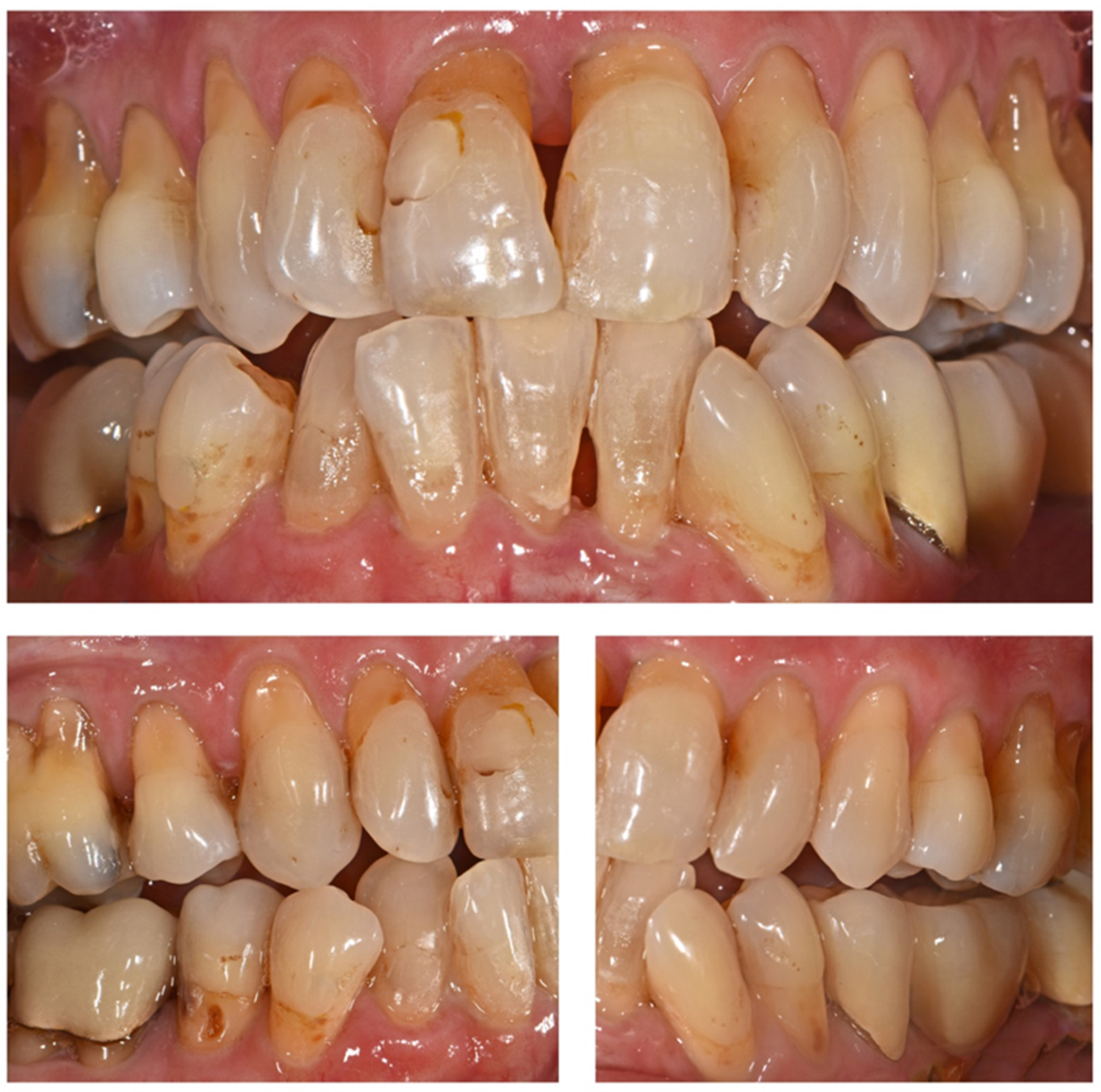
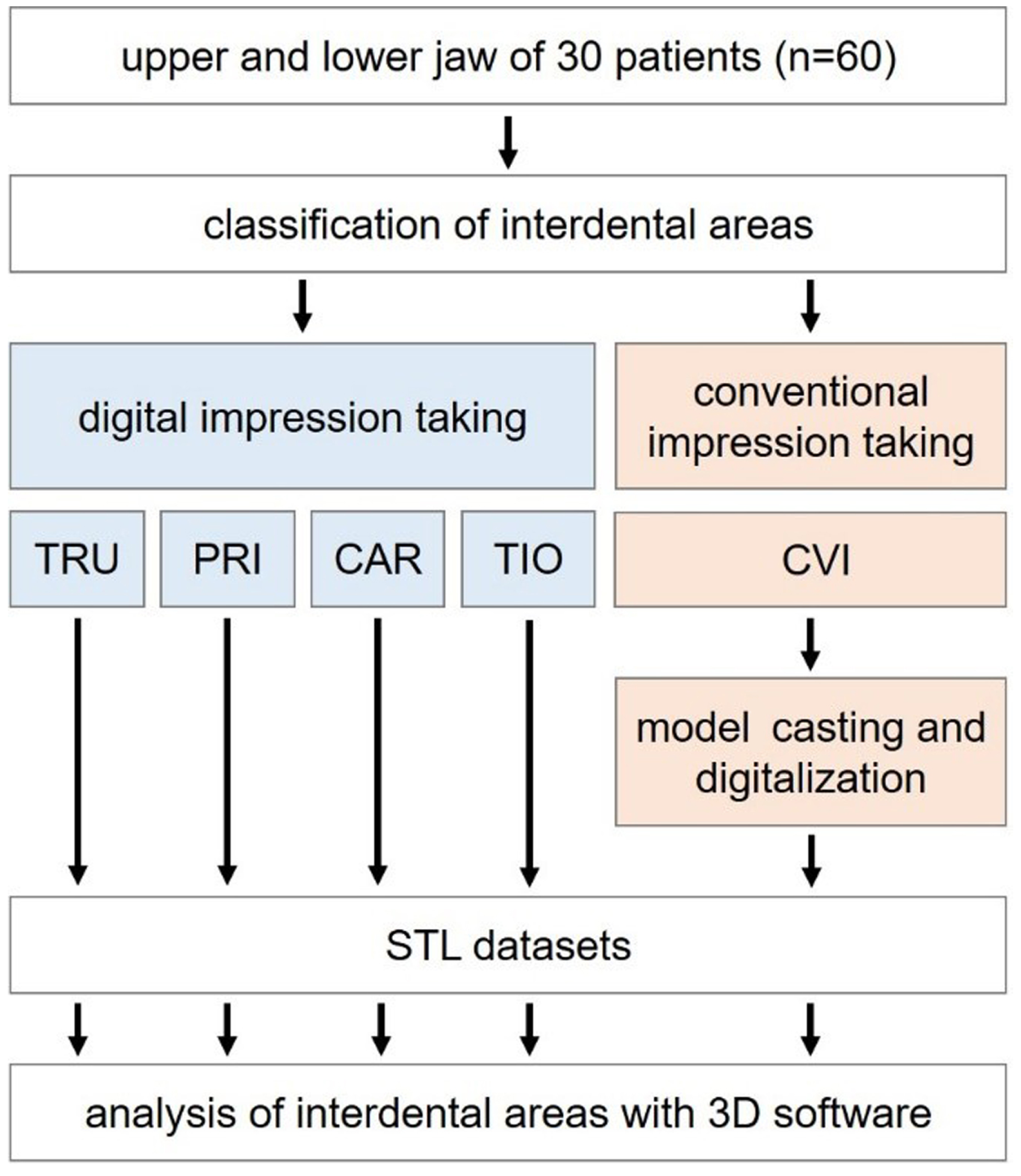
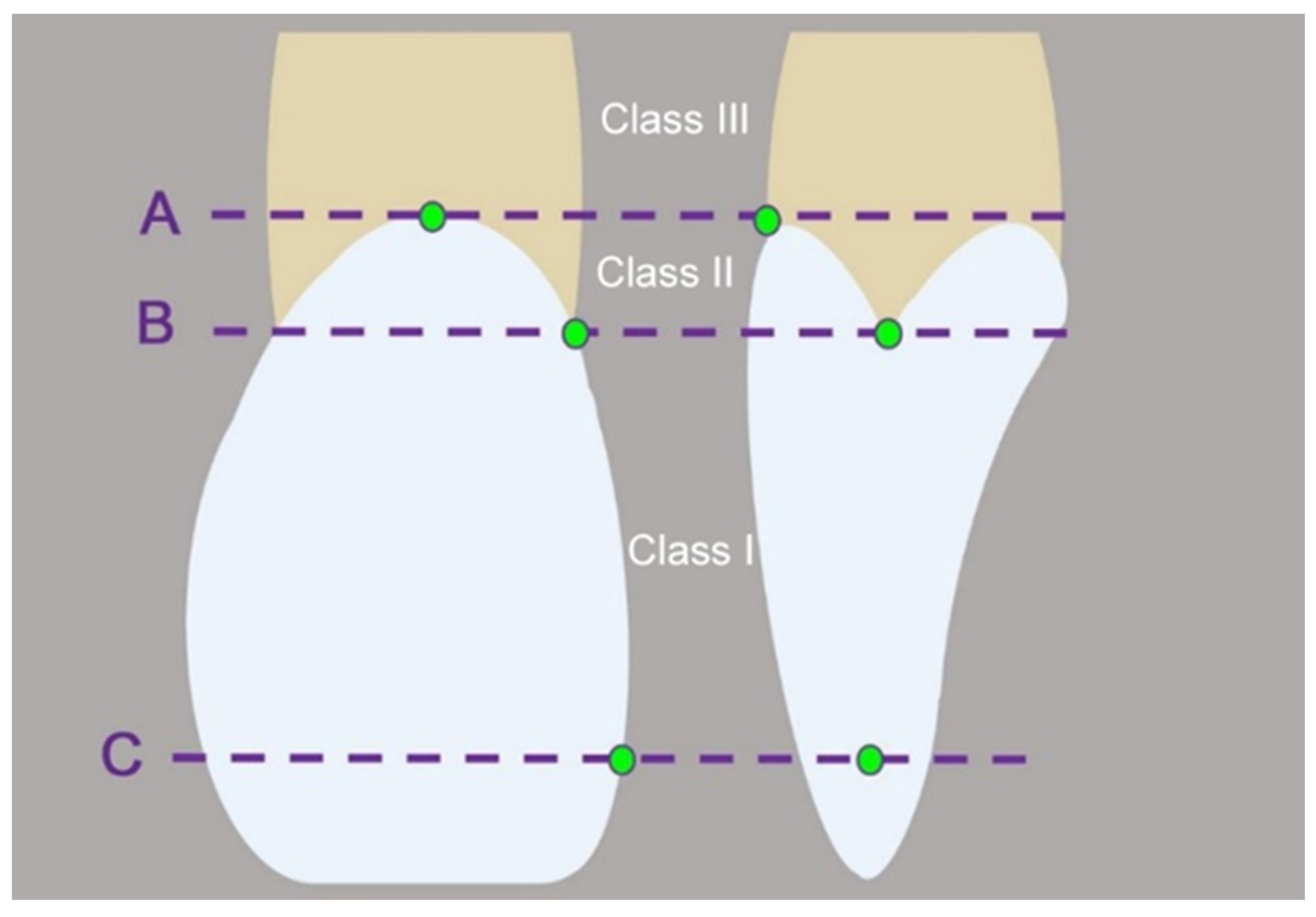
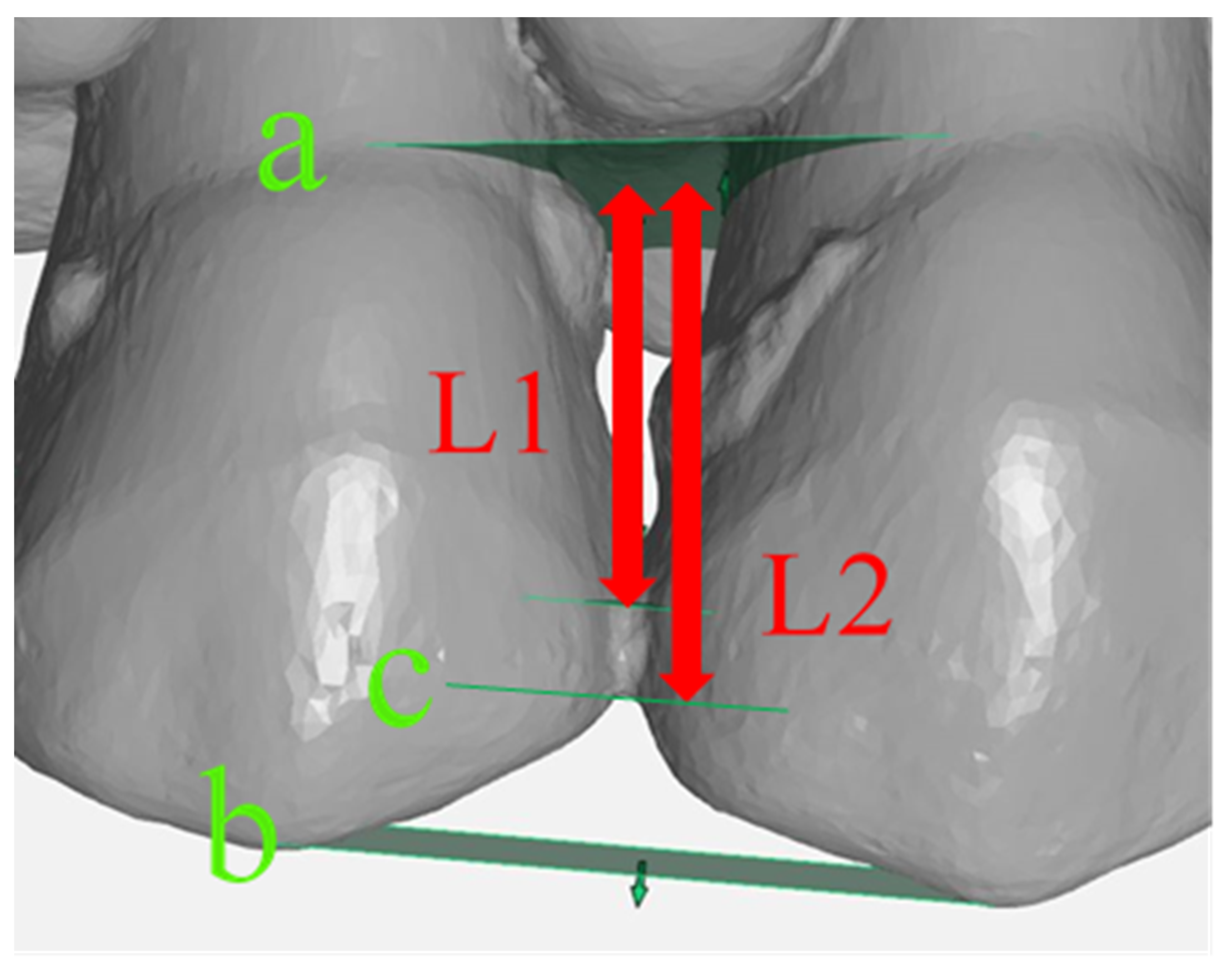

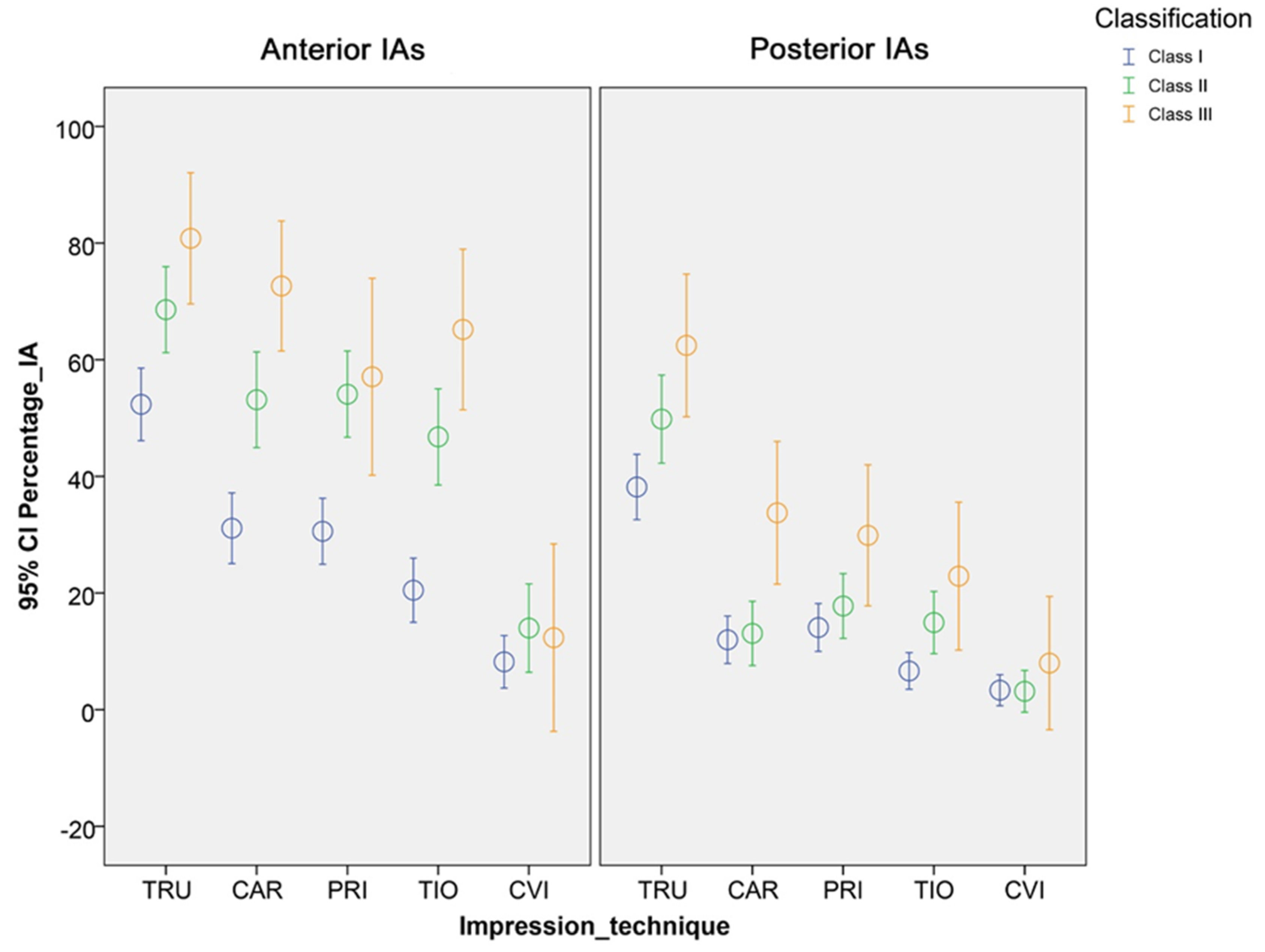
| Classification | Description |
|---|---|
| Class I | The tip of the interdental papilla lies between the interdental contact point and the most coronal extent of the cemento-enamel junction (CEJ) (space present but interproximal CEJ is not visible). |
| Class II | The tip of the interdental papilla lies at or apical to the interdental CEJ, but coronal to the apical extent of the facial CEJ (interapproximal visible). |
| Class III | The tip of the interdental papilla lies level with or apical to the facial CEJ. |
| Abbreviation | Product Name | Software Version | Manufacturer |
|---|---|---|---|
| TRU | True definition | 5.1.1 | 3M (Saint Paul, MN, USA) |
| PRI | Primescan | 5.0.1 | Dentsply Sirona (Bensheim, Germany) |
| CAR | CS 3600 | 3.1.0 | Carestream Dental (Stuttgart, Germany) |
| TIO | Trios 3 Cart | 18.2.10 | 3Shape (Copenhagen, Denmark) |
| Classification | Impression Technique | Descriptive Statistics | p-Values (Corrected by Bonferroni) | |||||
|---|---|---|---|---|---|---|---|---|
| 25th Percentile | Median | 75th Percentile | PRI | CAR | TIO | CVI | ||
| Class I | TRU | 0.00 | 62.26 | 82.1 | <0.001 | <0.001 | <0.001 | <0.001 |
| PRI | 0.00 | 9.77 | 55.1 | - | 1 | 0.018 | <0.001 | |
| CAR | 0.00 | 0.00 | 59.01 | - | - | 0.168 | <0.001 | |
| TIO | 0.00 | 0.00 | 44.04 | - | - | - | <0.001 | |
| CVI | 0.00 | 0.00 | 0.00 | - | - | - | - | |
| Class II | TRU | 62.32 | 76.2 | 100.00 | <0.001 | 1 | <0.001 | <0.001 |
| PRI | 38.58 | 58.45 | 74.85 | - | 1 | 1 | <0.001 | |
| CAR | 7.85 | 58.88 | 86.30 | - | - | 1 | <0.001 | |
| TIO | 0.00 | 49.68 | 76.75 | - | - | - | <0.001 | |
| CVI | 0.00 | 0.00 | 0.00 | - | - | - | - | |
| Class III | TRU | 63.43 | 87.26 | 100.00 | 0.152 | 1 | 0.160 | <0.001 |
| PRI | 28.50 | 61.85 | 84.30 | - | 1 | 1 | <0.001 | |
| CAR | 51.56 | 73.92 | 94.92 | - | - | 1 | <0.001 | |
| TIO | 42.58 | 70.34 | 88.72 | - | - | - | <0.001 | |
| CVI | 0.00 | 0.00 | 0.00 | - | - | - | - | |
| Classification | Impression Technique | Descriptive Statistics | p-Value (Corrected by Bonferroni) | |||||
|---|---|---|---|---|---|---|---|---|
| 25th Percentile | Median | 75th Percentile | PRI | CAR | TIO | CVI | ||
| Class I | TRU | 0.00 | 40.51 | 72.26 | <0.001 | <0.001 | <0.001 | <0.001 |
| PRI | 0.00 | 0.00 | 0.00 | - | 1 | 0.021 | <0.001 | |
| CAR | 0.00 | 0.00 | 0.00 | - | - | 1 | <0.001 | |
| TIO | 0.00 | 0.00 | 0.00 | - | - | - | 0.154 | |
| CVI | 0.00 | 0.00 | 0.00 | - | - | - | - | |
| Class II | TRU | 0.00 | 59.85 | 78.69 | <0.001 | <0.001 | <0.001 | <0.001 |
| PRI | 0.00 | 0.00 | 37.44 | - | 0.667 | 1 | <0.001 | |
| CAR | 0.00 | 0.00 | 0.00 | - | - | 1 | <0.001 | |
| TIO | 0.00 | 0.00 | 33.13 | - | - | - | <0.001 | |
| CVI | 0.00 | 0.00 | 0.00 | - | - | - | - | |
| Class III | TRU | 63.43 | 87.26 | 100.00 | <0.001 | <0.001 | <0.001 | <0.001 |
| PRI | 28.50 | 61.85 | 84.30 | - | 1 | 1 | <0.001 | |
| CAR | 51.56 | 73.92 | 94.91 | - | - | 1 | <0.001 | |
| TIO | 42.58 | 70.34 | 88.72 | - | - | - | 0.020 | |
| CVI | 0.00 | 0.00 | 0.00 | - | - | - | - | |
© 2020 by the authors. Licensee MDPI, Basel, Switzerland. This article is an open access article distributed under the terms and conditions of the Creative Commons Attribution (CC BY) license (http://creativecommons.org/licenses/by/4.0/).
Share and Cite
Schlenz, M.A.; Schubert, V.; Schmidt, A.; Wöstmann, B.; Ruf, S.; Klaus, K. Digital versus Conventional Impression Taking Focusing on Interdental Areas: A Clinical Trial. Int. J. Environ. Res. Public Health 2020, 17, 4725. https://doi.org/10.3390/ijerph17134725
Schlenz MA, Schubert V, Schmidt A, Wöstmann B, Ruf S, Klaus K. Digital versus Conventional Impression Taking Focusing on Interdental Areas: A Clinical Trial. International Journal of Environmental Research and Public Health. 2020; 17(13):4725. https://doi.org/10.3390/ijerph17134725
Chicago/Turabian StyleSchlenz, Maximiliane Amelie, Victoria Schubert, Alexander Schmidt, Bernd Wöstmann, Sabine Ruf, and Katharina Klaus. 2020. "Digital versus Conventional Impression Taking Focusing on Interdental Areas: A Clinical Trial" International Journal of Environmental Research and Public Health 17, no. 13: 4725. https://doi.org/10.3390/ijerph17134725
APA StyleSchlenz, M. A., Schubert, V., Schmidt, A., Wöstmann, B., Ruf, S., & Klaus, K. (2020). Digital versus Conventional Impression Taking Focusing on Interdental Areas: A Clinical Trial. International Journal of Environmental Research and Public Health, 17(13), 4725. https://doi.org/10.3390/ijerph17134725






